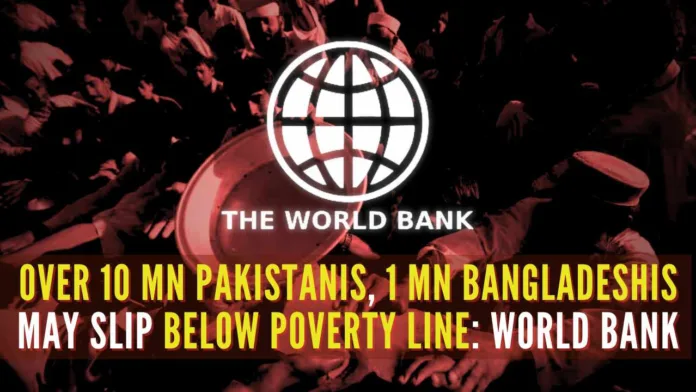
WB report warns of persistent rise in inflation and cost-of-living crisis
The World Bank has cautioned that over 10 million Pakistanis may fall below the poverty line, mainly due to a slothful economic growth rate and spiraling inflation at a staggering 26 percent for the current fiscal year.
The World Bank’s bi-annual report titled ‘Pakistan Development Outlook‘ sketched out a very grim picture of the country’s economy, giving indications that it is poised to fall short of meeting any of its major macroeconomic targets.
Nearly 1 million Bangladeshi people are projected to join the ranks of the moderately poor, who earn less than $3.65 a day in purchasing power parity (PPP), said the World Bank in its Poverty Macro Update on Bangladesh.
Released as part of the South Asia Development Update on Tuesday, the report said half a million people in Bangladesh are expected to slip into extreme poverty between the fiscal year 2023 (FY23) and fiscal year 2024 (FY24) due to the erosion of purchasing power, as inflation will reach 9.6 percent, Xinhua news agency reported.
The WB report on Pakistan also highlighted that Pakistan is expected to miss its primary budget target as well, which would keep Islamabad in deficit for at least three more years.
“Despite a broad-based yet nascent economic recovery, poverty alleviation efforts remain insufficient,” said Sayed Murtaza Muzaffari, lead author of the WB report.
“Economic growth is projected to stagnate at a paltry 1.8 percent maintaining the poverty rate at around 40 percent with approximately 98 million Pakistanis already grappling with poverty. The vulnerability of those hovering just above the poverty line, with 10 million individuals at risk of slipping into poverty in the face of shocks,” he added.
The WB report also warns that the persistent rise in inflation and cost-of-living crisis coupled with high transportation costs had the potential to trigger an increase in out-of-school children and delayed medical treatments, while food security remains a serious and major challenge in the country.
“Poverty reduction is projected to stall in the medium term due to weak growth, low real labor incomes, and persistently high inflation,” stated the WB report.
“Chronic inflation in the absence of substantial growth, along with policy uncertainty, could cause social discontent and have negative welfare impacts,” the report added.
All the above-mentioned and many more such indicators on circular debts, inflation, and GDP growth show a very grim and weak picture of Pakistan’s economy and its growth forecasts for at least three years or more, giving no hope to the locals, who are fast falling under the poverty line every day.
For all the latest updates, download PGurus App.
- Another jolt to Congress in MP as Six-time MLA Ramniwas Rawat joins BJP - April 30, 2024
- Amit Shah’s doctored video case: Delhi Police summons 16 leaders from 7 states - April 30, 2024
- Ahead of third phase, PM Modi writes to BJP candidates; urges to spotlight Congress’ politics of ‘division and appeasement’ - April 30, 2024











Bangladesh will get swallowed by sea i.e. sea will bless them
Peaceful & most democratic country in the world